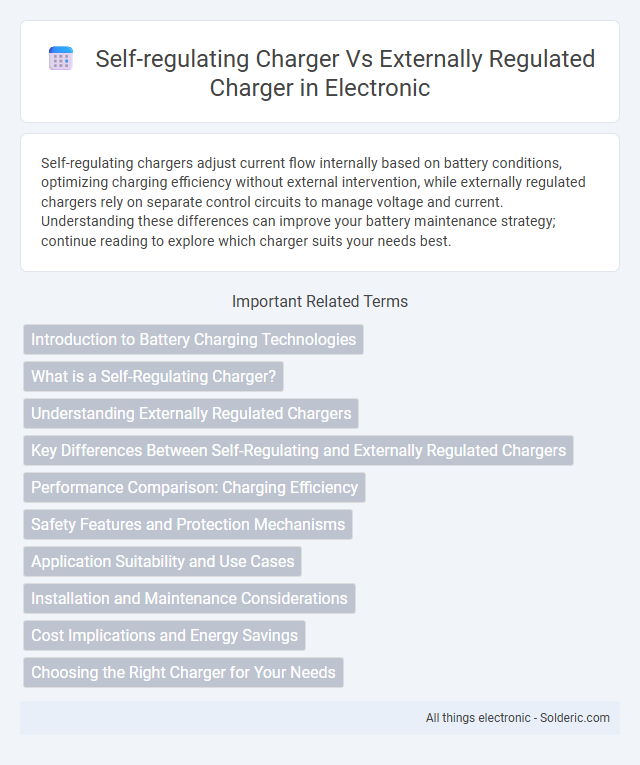Self-regulating chargers adjust current flow internally based on battery conditions, optimizing charging efficiency without external intervention, while externally regulated chargers rely on separate control circuits to manage voltage and current. Understanding these differences can improve your battery maintenance strategy; continue reading to explore which charger suits your needs best.
Comparison Table
| Feature | Self-regulating Charger | Externally Regulated Charger |
|---|---|---|
| Regulation Method | Built-in automatic voltage/current control | Uses an external controller for voltage/current regulation |
| Complexity | Simple, integrated design | More complex due to additional external components |
| Cost | Generally lower cost | Typically higher cost due to external parts |
| Flexibility | Fixed charging parameters | Highly customizable charging settings |
| Maintenance | Low maintenance | Requires monitoring of external regulator |
| Application | Best for small batteries and simple systems | Preferred for large battery banks and precise control |
| Efficiency | Moderate efficiency | Higher efficiency with proper regulation |
Introduction to Battery Charging Technologies
Self-regulating chargers automatically adjust the charging current based on the battery's voltage and temperature, ensuring efficient and safe charging without external intervention. Externally regulated chargers rely on a separate controller to manage the charging process, offering precise control but requiring additional components. Understanding these two battery charging technologies helps you select the optimal charger for prolonging battery life and maintaining performance.
What is a Self-Regulating Charger?
A self-regulating charger automatically adjusts its charging current based on the battery's state, preventing overcharging and extending battery life. It uses built-in sensors to monitor voltage and temperature, ensuring optimal and safe charging without external control. This contrasts with externally regulated chargers, which rely on an external device or circuit to manage the charging process.
Understanding Externally Regulated Chargers
Externally regulated chargers use a control circuit located outside the battery to manage voltage and current, ensuring precise charging and protecting the battery from overcharging or overheating. Unlike self-regulating chargers, which rely on the battery's chemical properties to limit charging, externally regulated chargers provide stable and consistent power delivery ideal for sensitive or high-capacity batteries. This method enhances battery lifespan and efficiency by maintaining optimal charging parameters throughout the process.
Key Differences Between Self-Regulating and Externally Regulated Chargers
Self-regulating chargers automatically adjust the charging current based on the battery's temperature and state, preventing overcharging and enhancing battery lifespan. Externally regulated chargers require an external control circuit to manage charging parameters, offering customizable settings but more complexity in setup. Your choice between these chargers impacts ease of use, protection level, and charging efficiency depending on your specific battery management needs.
Performance Comparison: Charging Efficiency
Self-regulating chargers optimize battery voltage by automatically adjusting current flow based on the battery's charge level, resulting in high charging efficiency and reduced energy waste. Externally regulated chargers rely on fixed voltage or current settings controlled by external circuits, which may lead to overcharging or undercharging and lower overall efficiency. Consequently, self-regulating chargers deliver faster charging times and improved battery lifespan through precise energy management.
Safety Features and Protection Mechanisms
Self-regulating chargers feature built-in mechanisms that automatically adjust voltage and current to prevent overcharging, overheating, and short circuits, enhancing battery safety without external intervention. Externally regulated chargers rely on separate control units to monitor and manage charging parameters, providing an added layer of protection but requiring precise calibration for optimal performance. Both systems incorporate safety features like thermal cutoff switches and reverse polarity protection, but self-regulating chargers offer more seamless, integrated safeguards during the charging cycle.
Application Suitability and Use Cases
Self-regulating chargers are ideal for small to medium battery systems, providing seamless voltage control by adjusting current internally, making them suitable for applications like portable electronics and automotive batteries where simplicity and compactness are crucial. Externally regulated chargers offer precise voltage and current management via an external controller, making them better suited for complex industrial setups, large-scale renewable energy systems, and lead-acid battery banks requiring strict charge regulation. Your choice depends on the specific application demands, battery type, and the level of control needed for optimal battery health and performance.
Installation and Maintenance Considerations
Self-regulating chargers simplify installation by automatically adjusting charging voltage based on battery condition, reducing the need for manual configuration and minimizing the risk of overcharging. Externally regulated chargers require precise setup and periodic adjustments to maintain optimal voltage levels, demanding more frequent maintenance and technical knowledge. Maintenance for self-regulating chargers is generally lower due to their adaptive controls, whereas externally regulated systems necessitate regular monitoring and calibration to ensure battery longevity and performance.
Cost Implications and Energy Savings
Self-regulating chargers typically offer lower upfront costs due to simpler design and fewer components, making them an economical choice for basic applications. Externally regulated chargers, while more expensive initially, deliver greater energy savings by precisely controlling charge cycles, reducing battery overcharging and extending battery life. Investing in externally regulated chargers can lead to significant long-term cost reductions through enhanced energy efficiency and decreased battery replacement frequency.
Choosing the Right Charger for Your Needs
Self-regulating chargers automatically adjust the charging current based on battery voltage, preventing overcharging and ensuring optimal battery health for applications like lead-acid or lithium-ion batteries. Externally regulated chargers require an external device to control the voltage and current, offering greater flexibility and precision in complex charging scenarios such as industrial or custom battery systems. Selecting the right charger depends on your battery type, required charging precision, and the complexity of your system's power management needs.
Self-regulating charger vs Externally regulated charger Infographic

 solderic.com
solderic.com